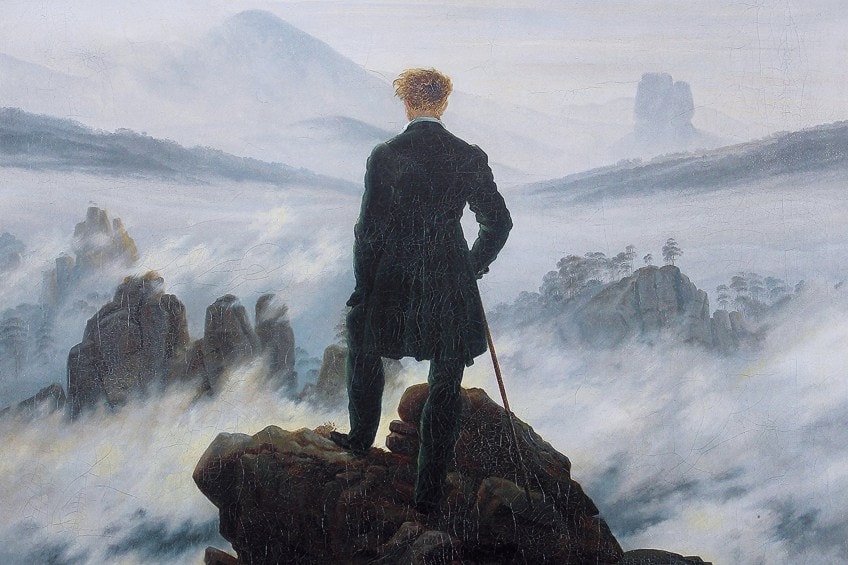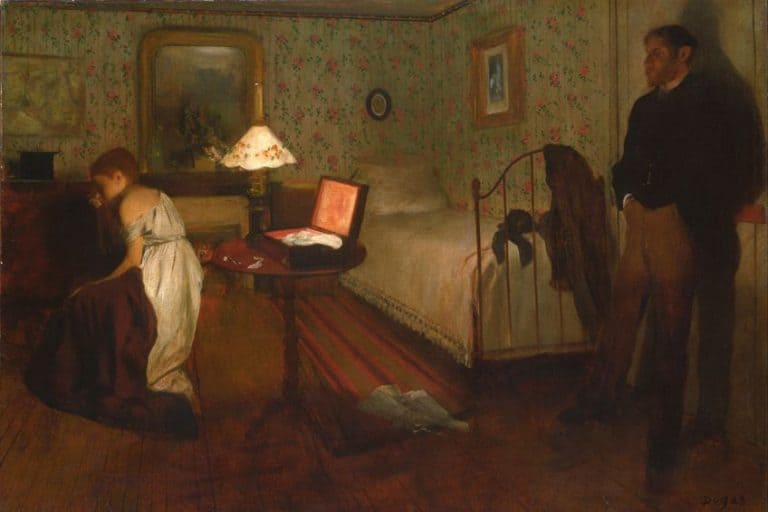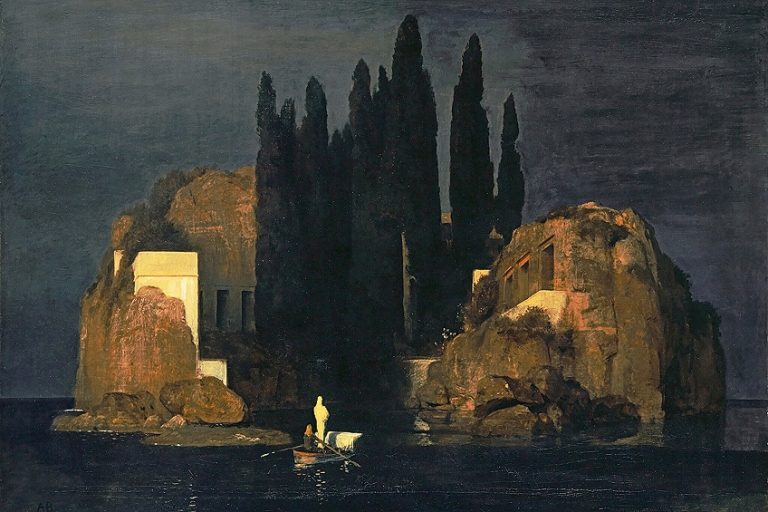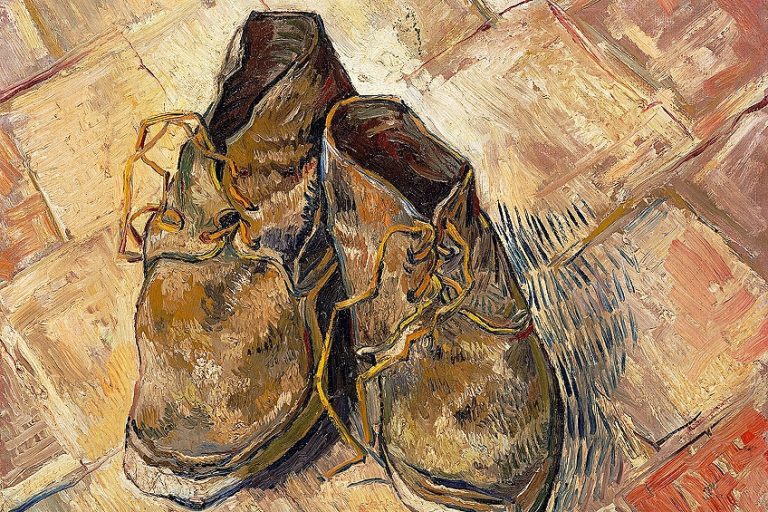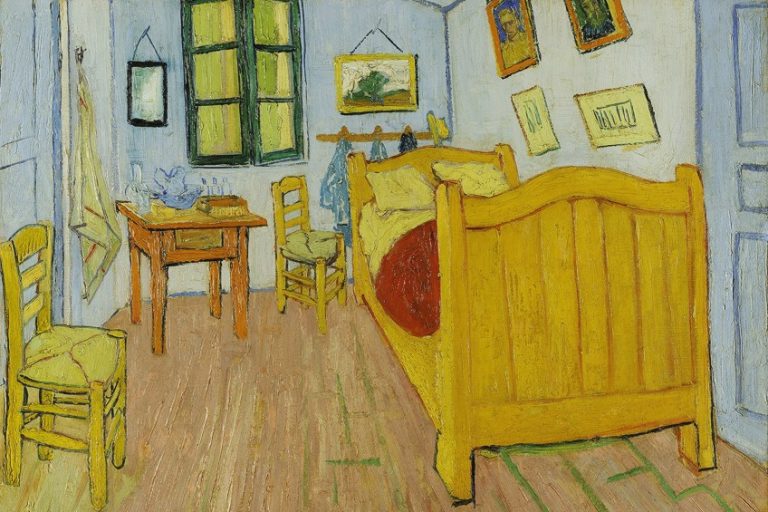Famous Romanticism Paintings – The Best Examples of Romantic-Era Art
The Romanticism movement was a force that dominated Europe during the late 1800s. It was an artistic, intellectual, and literary movement cultivated as a reaction to the Classicism and Neoclassicism movements that preceded it. A distinct break from the trends of intellectual thought, industrialization, rationalization, and glorification of science. The Romanticism movement was emotionally charged and sought to entertain the imagination, we see that in the fantastical and inspired paintings that emerged from this period. In this article, we will explore the 12 most famous Romanticism paintings.
Romanticism: A Brief Overview
Romanticism indulged the artist’s emotions and imagination, allowing these feelings and ideas to permeate the viewer. Romanticism was interpreted differently by various Romantics regarding their music, literature, and visual art. Artists portrayed scenes of love, beauty, suspense, horror, anger, and adoration that were aimed to provide an escape from reality.
The Romantic period spanned from around 1790 to 1880 and arose from dissatisfaction with the Enlightenment’s values of order and reason after the French Revolution in 1789. Although Romanticism has been detailed as the antithesis of the Classicism and Neoclassicism movements, stylistically there were overlaps among them.
However, Romanticism did have several distinctions from its preceding movements, as it was characterized by its emphasis on sentiment and passion as opposed to prior conventions of rationality and detachment.
In the visual arts, Romantics paid homage to the power of nature, honoring its unpredictability and beauty. Nature’s potential for disaster was a prominent theme, along with the portrayal of commanding, poignant feelings that induced empathy. Romantics glorified emotion and intuition over logic and intellect. Romanticism art was attuned to beautiful scenes of nature and the sublime, incorporating the way humans feel in nature.
Danger and beauty defined nature’s sublime aesthetic.
In opposition to Rationalism, Romantic painters dressed their artworks with bright colors and energetic brushstrokes. Romanticism art favored dynamic compositions over static ones. Romantic-era paintings were used to express individuality and instinct instead of depicting idealized representations of the Classical past.
12 Most Famous Romanticism Paintings
Romanticism artwork offered a fantastical escape from the reality of urban life. Romanticism focused on feelings and the condition of the soul, which was often reflected in nature. Romantic period artists did not simply paint what they saw in a landscape but painted the way they felt from the landscape. Artists were free to be creative, harnessing inspiration from their dreams and their consciousness to illustrate fantastic figures or troubled landscapes. Here is our selection of the 12 most famous Romanticism paintings.
The Nightmare (1781) by Henry Fuseli
| Artist | Henry Fuseli |
| Date Painted | 1781 |
| Medium | Oil on canvas |
| Dimensions | 101.6 cm x 127 cm |
| Where It Is Currently Housed | Detroit Institute of Art, Michigan, the United States of America |
Henry Fuseli’s Romantic artwork, The Nightmare, was the first of its kind making Fuseli somewhat of a transitional figure– leading the progression of art from The Age of Reason to Romantic-era art. Fuseli’s peculiar and macabre artwork depicts a seemingly spellbound woman in deep sleep draped across a divan.
The woman has her arms stretched below her, with a demon-like incubus crouched on top of her, glaring threateningly at the viewer. Partially hidden, we see a mysterious mare with bewitching white eyes and flaring nostrils. In Fuseli’s ghastly portrayal, he paints the woman in an idealized manner, which coincides with the principles of Neoclassicism.
However, he deviated from this by using his painting to explore the darker depths of the human psyche, while most were busied with the scientific exploration of the physical world.
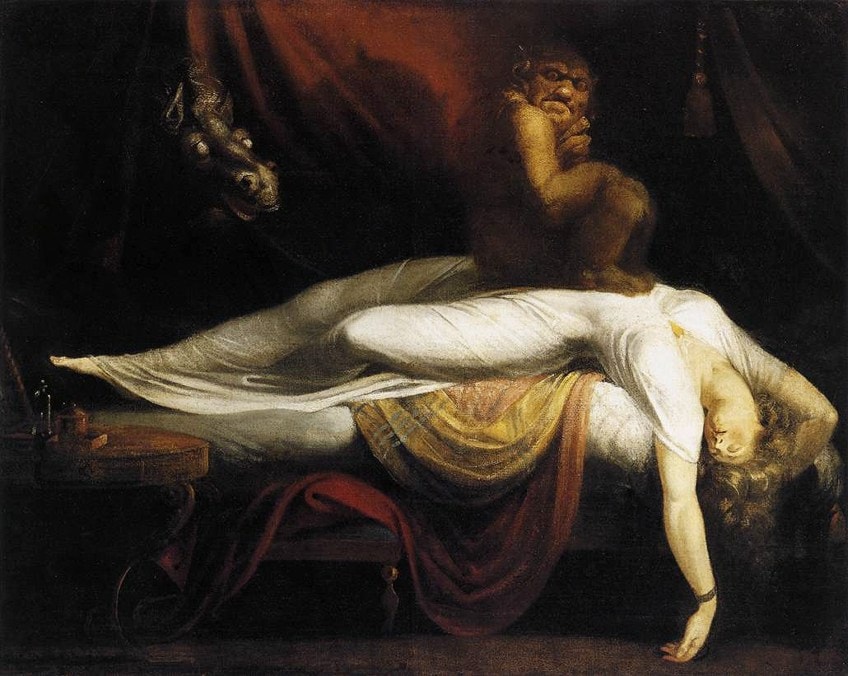
Although the woman is enveloped in bright light, Fuseli suggests that the light cannot pierce the nightmarish realm of the human mind. The relationship between the woman, the incubus, and the mare is not explicit and therefore remains suggestive, emphasizing the frightening possibilities.
The Nightmare frightened and shocked its audience when exhibited at London’s Royal Academy. It was unlike anything the public was used to seeing, as the subject matter was not taken from the bible or a moment in history, nor was it created for the sake of moralizing the viewer.
Fuseli’s painting had a wide-reaching influence and changed the art world, as well as inspiring writers such as Edgar Allan Poe and Mary Shelly with his combination of sexuality, horror, and death acting as crucial elements for the Gothic horror genre.
Upper Fall of the Reichenbach: Rainbow (1810) by J. M. W. Turner
| Artist | J. M. W. Turner |
| Date Painted | 1810 |
| Medium | Watercolor, graphite, and white heightening on paper |
| Dimensions | 27.9 cm x 39.4 cm |
| Where It Is Currently Housed | Yale Centre for British Art, Connecticut, the United States of America |
Joseph Mallord William Turner was one of the pioneering Western artists to capture ambiance and mood in his Romanticism art pieces. Turner was an exceptionally influential 19th-century landscape painter. He became enraptured by the Reichenbach Falls, a waterfall of the River Aare close to Meiringen in Switzerland, which he witnessed during his travels in 1802. Upper Fall of the Reichenbach: Rainbow was a scene he painted numerous times both in Switzerland and in his home country of England.
Turner expressed the notion of the “sublime” in his paintings, a concept postulated by the philosopher Edmond Burke, where he depicted the feeling one sensed when experiencing the overwhelming force and grandeur of nature.
This becomes obvious by the sheer magnitude of the mountains in comparison to the human figure and animals in the bottom left corner of the painting. The minuscule figures indicate the sense of scale and demonstrate their insignificance while surrounded by the enormity of nature.

Turner skillfully painted in thin washes and layers, using a somber color palette, where he rubbed and scraped out the paper’s surface with a wet cloth to convey the dissolving and thunderous spray of the waterfalls against the enormous rocks. During this part of his career, there was more of a focus on tone and form, it was only later that color became more significant for him.
Turner introduced the landscape as an equally significant component of genre art, with paintings of everyday scenes of life– at the time, this was a revolutionary choice. Turner was celebrated as “the painter of light” because of his mastery of depicting luminous colors and atmosphere.
His dynamism and intensity contrasted substantially with the prevalent contemporary carefully painted topographical scenes.
Third of May 1808 (1814) by Francisco Goya
| Artist | Francisco Goya |
| Date Painted | 1814 |
| Medium | Oil on canvas |
| Dimensions | 268 cm x 347 cm |
| Where It Is Currently Housed | Museo Nacional Del Prado, Madrid, Spain |
Considered one of Spain’s most important artists of the 18th and 19th centuries, Francisco Goya created vivid and enigmatic artworks that reflected and commented on Spain’s contemporary historical turbulence. Goya’s groundbreaking famous Romantic art, The Third of May 1808, is arguably his most famous painting. It depicts Napoleonic troops publicly executing Spaniards as retribution for the previous day’s uprising against the French.
Goya’s brooding palette intensifies the atrocities and creates a feeling of overwhelming darkness.
The Spanish laborer who is about to be executed is represented in a manner that imitates Christ’s crucifixion. The figure is kneeling on the ground with his arms flung wide and his right hand is marked by Stigmata, similar to the marks made on the body of Christ during the crucifixion. The figures’ expressive faces and body language convey the cruelty and the turmoil. A lantern on the ground is the only source of light, which divides the scene into the light, highlighting the victims, and shadows, consuming the faceless executioners.
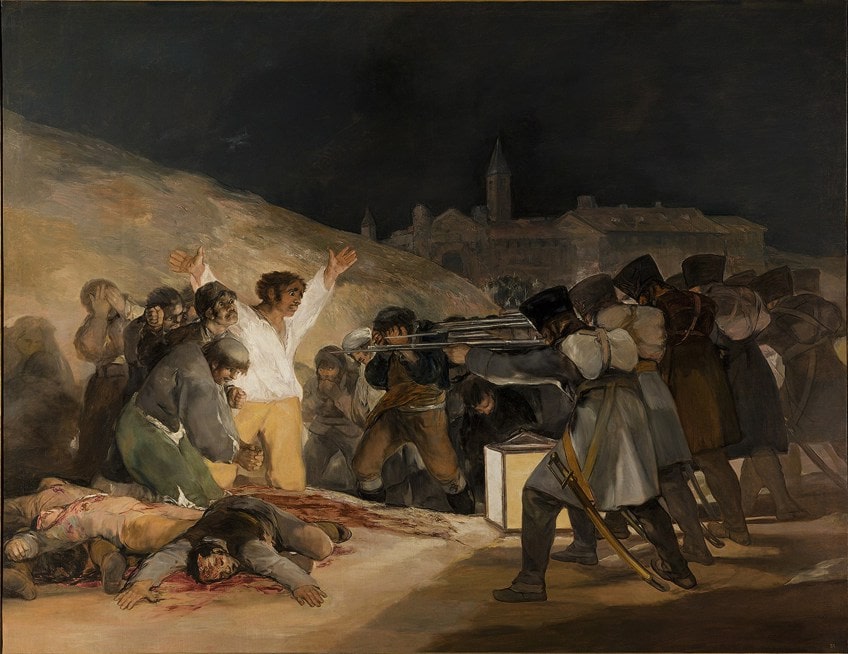
Goya created famous Romanticism paintings that broke decisively from the past. The painting was revolutionary, with its unheroic presentation, its granular and matte pigments, and the flatness of its perspective.
Together with Goya’s portrayal of a contemporary occasion that was experienced by ordinary people, this defied academic norms that preferred timeless Neoclassical scenes.
Goya aimed to witness and commemorate the Spanish opposition to Napoleon’s army. He influenced generations of artists that followed him. Goya’s revolutionary painting, The Third of May 1808, played a pivotal role in the rise of Realism and its honest depictions of everyday life, in influencing Picasso’s representations of the horrors of war, and in encouraging Surrealism’s examination of dream-like content.
Wanderer above the Sea of Fog (c. 1818) by Caspar David Friedrich
| Artist | Caspar David Friedrich |
| Date Painted | c. 1818 |
| Medium | Oil on canvas |
| Dimensions | 95 cm x 75 cm |
| Where It Is Currently Housed | Hamburger Kunsthalle, Hamburg, Germany |
The German Romantic period artist Caspar David Friedrich painted one of the most iconic Romantic-era artworks, Wanderer above the Sea of Fog, in 1818. Friedrich’s artwork depicts an explorer, a young man, from behind perched on a rugged outcrop as he looks beyond to a dense sea of fog. Wanderer above the Sea of Fog does not tell a story; it is Friedrich’s portrayal of an emotional state, one that depicts ideas of roaming and infinity, of the imperfection of emotions and the soul.
Friedrich’s masterpiece presented man against an eerie and mysterious backdrop, demonstrating his diminished power in the vast magnitude of life.
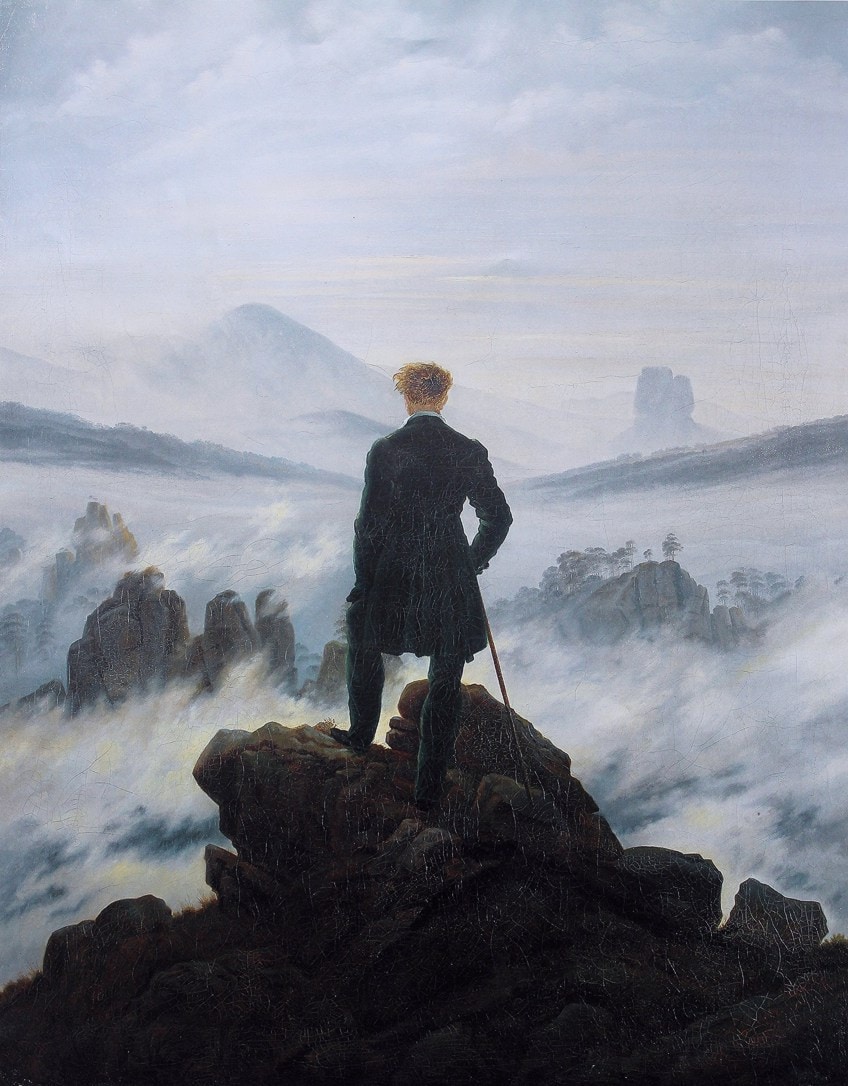
Friedrich skillfully used space to illustrate man’s minuscule standing in nature, a solitary figure amidst the immense landscape. The landscape is made up of composites of landmarks around Eastern Germany from the Elbe Sandstone Mountains. The wanderer seems to be contemplating the world that exists before him.
The man’s figure takes up a central position in the painting, which may suggest that he has command over the world before him. Yet, as the fog subtly blends into the horizon, we become aware of the scale of the landscape that stretches infinitely before him. We see that the world fundamentally remains unknown. Friedrich’s awe-inspiring painting elevated the landscape painting.
This Romanticism artwork is representative of German Romanticism, which had developed slightly differently from its Italian and French counterparts.
The Raft of the Medusa (1818 – 1819) by Théodore Géricault
| Artist | Théodore Géricault |
| Date Painted | 1818 – 1819 |
| Medium | Oil on canvas |
| Dimensions | 490 cm x 716 cm |
| Where It Is Currently Housed | Musée du Louvre, Paris, France |
Théodore Géricault’s famous Romantic art, The Raft of Medusa, depicted the shipwreck that took place in 1816 when hundreds of soldiers from the French Royal Navy were dispatched to colonize Senegal. The ship began to sink after hitting a sandbank and those who survived built an emergency raft to get to shore but were rapidly lost at sea.
Géricault spent months researching the event, speaking to and sketching survivors, studying cadavers, and called on friends to model, including the famous Eugène Delacroix.
The emotional significance of Géricault’s masterpiece is imprinted on the viewer. Géricault fused reality and art to deliberately portray an artistically and politically confrontational piece. Géricault’s decision to depict a Black man at the apex of the composition was incredibly controversial as it expressed his abolitionist sentiments.
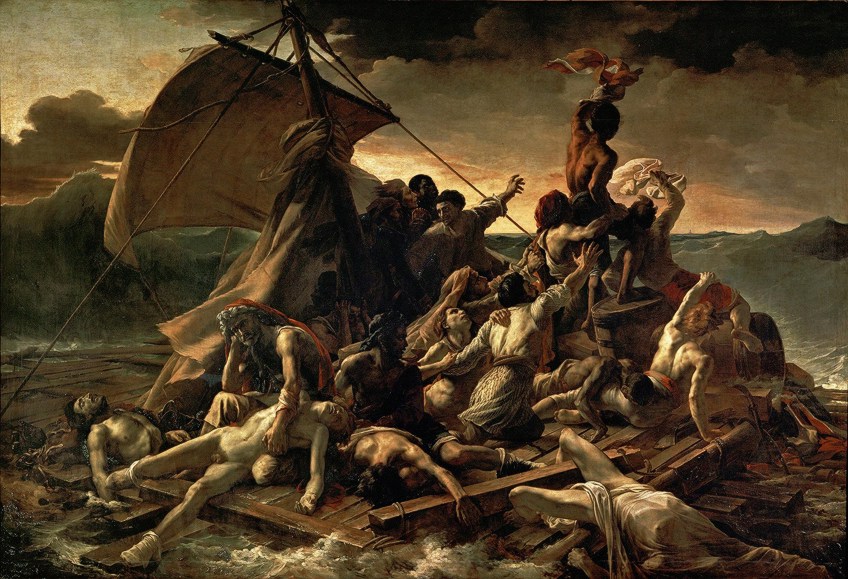
An intense spectacle is created by his use of light and shadow, along with its diagonal formation that divides the frame with the contorted bodies in the lower-left corner, leading the viewer’s eyes along the horrific scene to the pinnacle figure waving a cloth, issuing a sign of hope. Along the diagonal from the sail to the bottom right corner, we see a body partly shrouded, slipping into the sea.
This composition, together with the majestic and tempestuous sky is illustrative of Romanticism art pieces and their portrayals of the sublime.
Géricault’s painting generated substantial controversy and scandal when it was first exhibited in Paris. For the most part, the painting moved the viewing public, however many were repelled by Géricault’s choice of subject matter. It faced criticisms regarding its departure from Classicism as it disregarded the portrayal of “ideal beauty”, with its representation of Realism. When Géricault exhibited his work in London it had a considerably more positive reception, and it gained acclaim for introducing a new direction for French art.
The Hay Wain (1821) by John Constable
| Artist | John Constable |
| Date Painted | 1821 |
| Medium | Oil on canvas |
| Dimensions | 130.2 cm x 185.4 cm |
| Where It Is Currently Housed | National Gallery, London, United Kingdom |
John Constable was an English Romantic period artist dedicated to pastoral landscape artworks. The Hay Wain is arguably his greatest work and his unique ability to bring natural landscapes to life earned him great acclaim. The Hay Wain depicts a simple scene of English farmers tending to their work in this majestic painting. It demonstrates Constable’s brilliance, as he can capture in a painting how fleeting atmosphere dictates how we view landscapes.
In this painting, man does not simply observe nature from afar; Constable portrays him as an intricate part of nature, just as the birds and the trees are– not separate from it.

The figures are drawn to scale with the environment, suggesting Constable’s efforts to express the oneness with nature in his painting. The Hay Wain has been recognized as one of the most exceptional Romantic-era artworks depicting a landscape, as well as being one of the most revered works by an English artist.
When first exhibited, Constable’s masterpiece was considered provocative and impertinent, as the large painting seemingly used the same techniques, utilizing small brushstrokes, like the Impressionists.
According to London’s crowd, this was scandalous, whereas the French adored this manner of painting, employed by artists such as Géricault. When The Hay Wain was exhibited in Paris it caused quite the sensation. It earned Constable a gold medal from King Charles X of France, for the impact of his artwork at the Paris Salon.
Épisode des Journées de Septembre 1830 (1830) by Marie-Adélaïde Kindt
| Artist | Marie-Adélaïde Kindt |
| Date Painted | 1830 |
| Medium | Oil on canvas |
| Dimensions | Unknown |
| Where It Is Currently Housed | City Hall of Brussels, Belgium |
Unfortunately, very little is known about the artistic contributions of women during the Romanticism movement. This seems to be a consistent theme throughout art history– often ignored and rarely understood, women who have dedicated themselves to the visual arts have had to persevere.
One such woman is Marie-Adélaïde Kindt, a Belgian painter who was a leading artist during the 1820s and 1840s. Kindt was one among a few female artists that came from her family.
Antoine Cardon, an engraver, trained Kindt in the art of drawing. She then received Neoclassical training when studying painting under François-Joseph Navez, but the work she produced took on the influence of Romanticism.
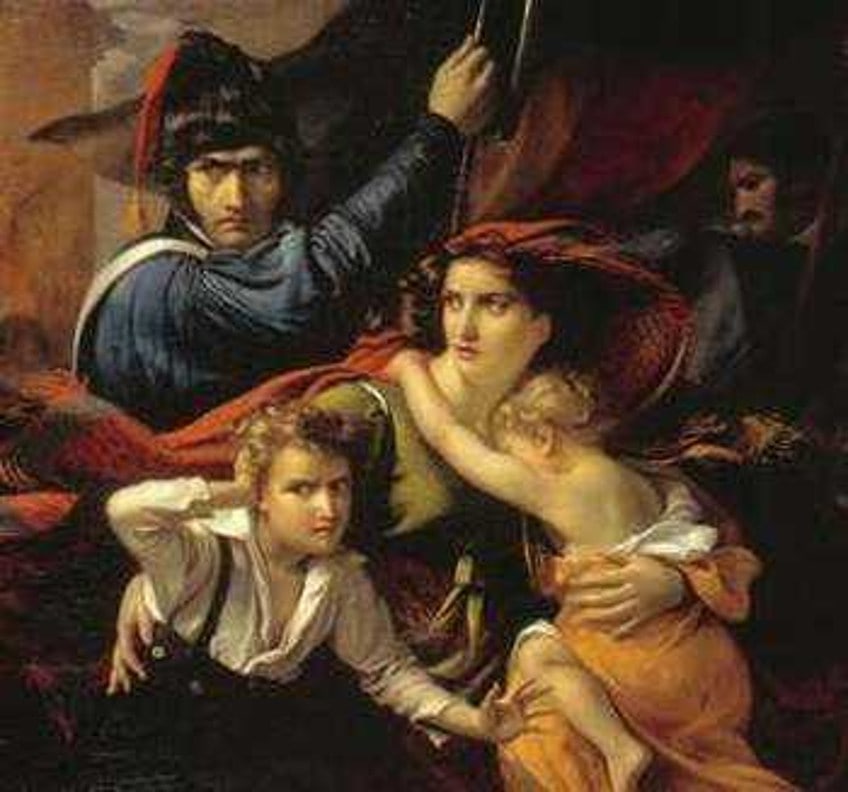
Kindt’s work comprised of many historic scenes, with her most influential piece being Épisode des Journées de Septembre 1830, which was a portrayal of the Belgian Revolution that took place the same year. Her masterpiece now sits in the City Museum in Brussels.
Kindt’s artistic contributions were encouraged by notable artists such as Jacques-Louis David. She continued to paint throughout her life, but her later work was less ambitious as she took on more Romanticism portraits and genre paintings, adjusting her style to cater to the taste of the public.
Kindt was not able to revive the success of her earlier career, but her legacy lives on with the pieces of art she left behind.
Liberty Leading the People (1830) by Eugène Delacroix
| Artist | Eugène Delacroix |
| Date Painted | 1830 |
| Medium | Oil on canvas |
| Dimensions | 260 cm x 325 cm |
| Where It Is Currently Housed | Musée du Louvre, Paris, France |
Eugène Delacroix is considered the most representative French Romanticism painter. Delacroix’s masterpiece, Liberty Leading the People, commemorates a scene from the July Revolution in 1830 where the abdicated King Charles X was overthrown. The painting was completed the same year event occurred. Not to be confused as a depiction of the 1789 French Revolution. Delacroix’s triumph represents freedom, revolution, and the people’s victory.
This captivating piece is one of the most well-known Romantic-era artworks.
Delacroix’s painted an allegory of the revolution rather than depicting an actual scene. Lady Liberty is depicted leading the unified group of people against the oppressor as an act of patriotism. Social class was not important, as can be seen by the mixture of people– the message was unity. Although the bare-chested figure is reminiscent of the Greek Classical ideal, with her dress draped over her frame, Delacroix depicts her with hair on her underarm to suggest that she is in fact real and not simply an ideal.
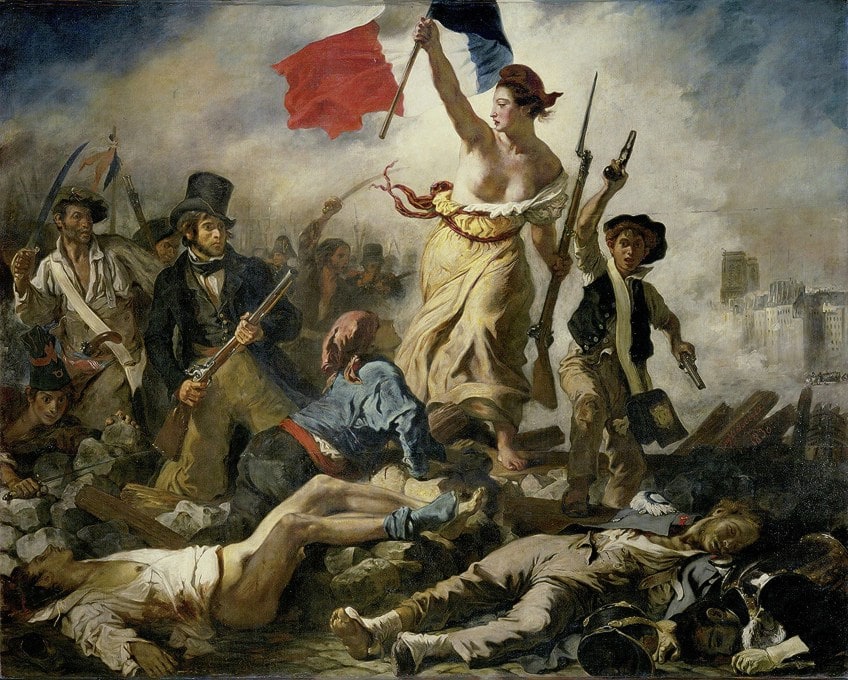
Liberty is depicted wearing a Phrygian cap, symbolic of freedom and the pursuit of liberty, holding a bayonet, and raising the tricolor flag as she encourages the rebellious group onwards on their course to victory. Every detail in Delacroix’s painting holds political significance and merges it with fierce emotions.
The turbulent scene highlights death, suffering, and heroism, which are archetypal themes of famous Romantic art.
Liberty Leading the People was a distinguished Romanticism artwork with a legacy that inspired notable works such as Liberty Enlightening the World (1886), more commonly known as the Statue of Liberty by Frédéric Auguste Bartholdi. Delacroix’s painting has been credited for inspiring the 1862 novel Les Misérables by Victor Hugo. To this day Liberty Leading the People continues to hold its weight, being featured on the 2008 album cover for Coldplay’s Viva la Vida.
The Titan’s Goblet (1833) by Thomas Cole
| Artist | Thomas Cole |
| Date Painted | 1833 |
| Medium | Oil on canvas |
| Dimensions | 49.2 cm x 41 cm |
| Where It Is Currently Housed | Metropolitan Museum of Art, New York, the United States of America |
Thomas Cole’s Romanticism artwork, The Titan’s Goblet, serves as the pinnacle of his Romantic fantasies. The Titan’s Goblet mimics Cole’s other famous Romanticism paintings, with its depiction of an Italian landscape and its illustration of themes relating to the grandeur of time past and nature’s significance and power for encroachment. The Titan’s Goblet is arguably Cole’s most enigmatic painting of his allegorical landscape works. The Metropolitan Museum of Art has expressed that this magnificent painting “defies full explanation”.
Cole’s painting is considered a “picture within a picture”, as two landscapes exist within the painting. The foot of the goblet stands on traditional terrain, yet a whole other world exists along its rim.

Lush vegetation runs along the rim, with two tiny buildings breaking the greenery, one is an Italian palace and the other a Greek temple. A vast body of water fills the goblet to the brim, and it is dotted with sailing boats. Water spills over onto the ground below marked by another civilization.
The Classical ruins which are found on the Goblet’s rim and the sailing boats that wade through the water have been linked to Greek and Norse mythology.
As they sit far removed from the civilization below, it has been interpreted as a disassociation from the present. Another theory relates the self-contained civilization to a microcosm of the human world amidst the commanding body of nature. The stem of the goblet then unites the past and the present. The Titan’s Goblet is recognized as a unique piece of artwork.
The Ninth Wave (1850) by Ivan Aivazovsky
| Artist | Ivan Aivazovsky |
| Date Painted | 1850 |
| Medium | Oil on canvas |
| Dimensions | 221 cm x 332 cm |
| Where It Is Currently Housed | The State Russian Museum, Mikhailovsky Palace, Russia |
Ivan Aivazovsky was a Russian-Armenian Romantic period artist who specialized in marine art. His triumph The Ninth Wave is recognized as one of the most exceptional seascapes of Romanticism art. The painting depicts massive waves sweeping across a volatile ocean. The wreckage floats in the painting’s foreground.
This painting gets its title and theme from an old sailor’s tale, a traditional belief that was held for centuries preceding the 1800s, where the ninth wave was said to be the most enormous and destructive.
The figures cling to the debris from the ship, in the face of death they attempt to save themselves. It is suggested that the wreckage forms the shape of a cross, indicating a religious undertone in Aivazovsky’s work. This work serves as an allegory, according to Christianity, for salvation from sin.
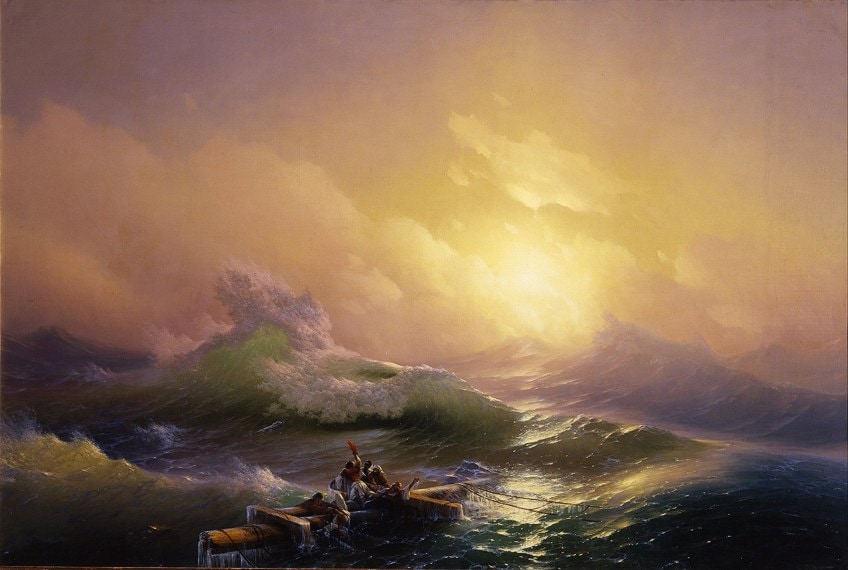
The palette of the painting utilizes warm tones, diminishing the ferocity of the sea and conveying a sense of hope and a chance for survival. Aivazovsky masterfully demonstrates the beauty and devastation of nature.
Aivazovsky’s talents gained him international acclaim, leading him to be one of the few Russian painters to achieve such success during his lifetime.
To this day, he remains one of the most distinguished marine artists, speaking to the impact of his artistic feats. Anton Chekhov, a famous Russian writer, once described something as “worthy of Aivazovsky’s brush”, which then became the standard phrase referenced when describing anything that was overwhelmingly beautiful.
The Kiss (1859) by Francesco Hayez
| Artist | Francesco Hayez |
| Date Painted | 1859 |
| Medium | Oil on canvas |
| Dimensions | 110 cm x 88 cm |
| Where It Is Currently Housed | Pinacoteca di Brera, Milan, Italy |
Francesco Hayez was a famous Italian Romantic period artist and his painting, The Kiss, is considered his best-known work. Alfonso Maria Visconti di Saliceto commissioned the painting, later donating it to the Pinacoteca di Brera. The Kiss depicts a man and a woman embracing in a passionate kiss, enveloped into one another, their faces remain hidden.
The figures represent a couple from the Middle Ages as suggested by their dress. However, they remain unrecognizable, as Hayez wanted the focus to remain on the act of their embrace.
The Kiss showcases Hayez’s incredible skill as he executed his painting with such fine detail. Hayez fused scenes of exceptional beauty with political accounts. The underlying message Hayez imparts on the viewer is that of a national union as the painting was representative of Risorgimento, the “Italian Unification”.
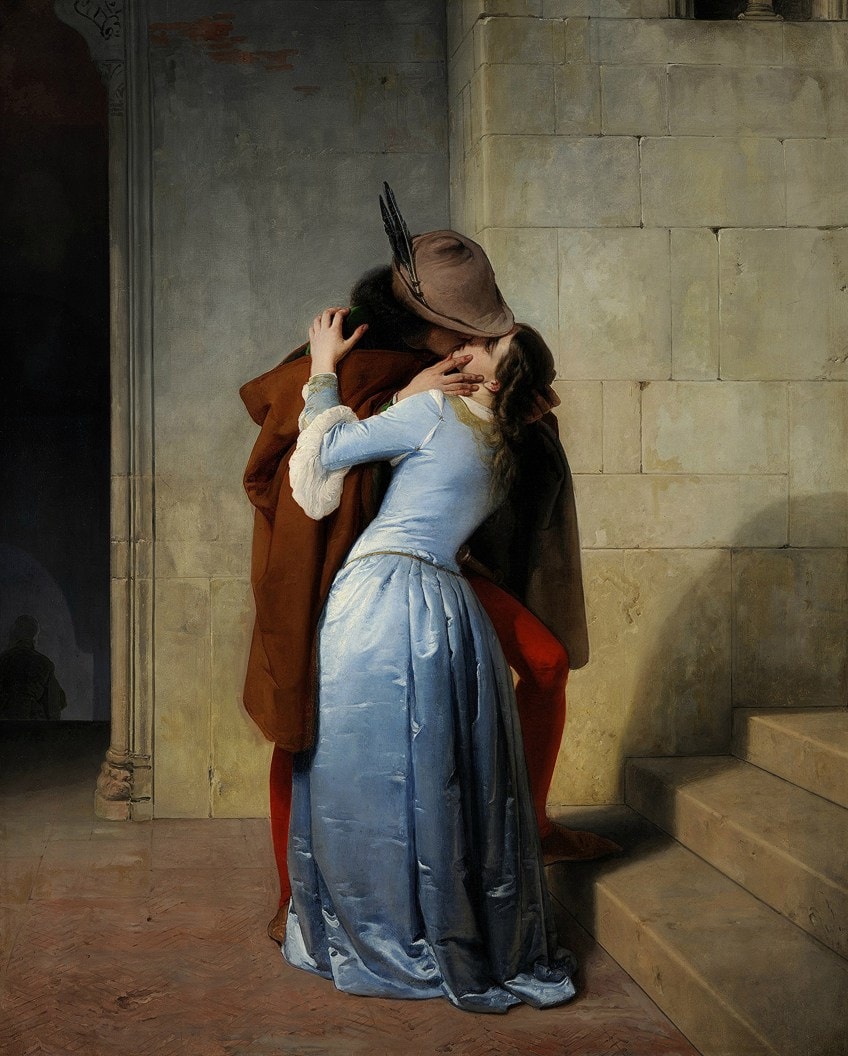
Hayez aimed to pay homage to the French because they were allied to Italy, hence the painting’s chromatic range with the red of the man’s tights, and the white and blue of the woman’s dress, alluding to the French flag.
This painting is a symbolic masterpiece that has come to represent Italian Romanticism.
Hayez is regarded as Italy’s most famous Romantic-era artist, with artistic contributions that stretch from magnificent Romanticism portraits to monumental historical paintings. His influence had an instrumental impact on the generations of artists that followed in Italy. The Kiss relished in its popularity from the first time it was exhibited and onwards. Luchino Visconti, an Italian director, took inspiration from The Kiss for a scene in his 1954 production, Senso.
Kaaterskill Creek (c. 1870) by Susie M. Barstow
| Artist | Susie M. Barstow |
| Date Painted | c. 1870 |
| Medium | Oil on canvas |
| Dimensions | Unknown |
| Where It Is Currently Housed | Private Collection |
Susie M. Barstow was a member of the Hudson River School, which was a mid-19th-century American art movement that was incorporated by a class of landscape painters whose visual compositions were heavily influenced by Romanticism. The Hudson River Valley was regularly depicted by the artists as well as its surrounding areas, which included the Catskill Mountains. Barstow was known for her luminous landscapes, such as her majestic Kaaterskill Creek painting.
Barstow’s landscapes were infused with light, emanating serenity and the beauty of nature.
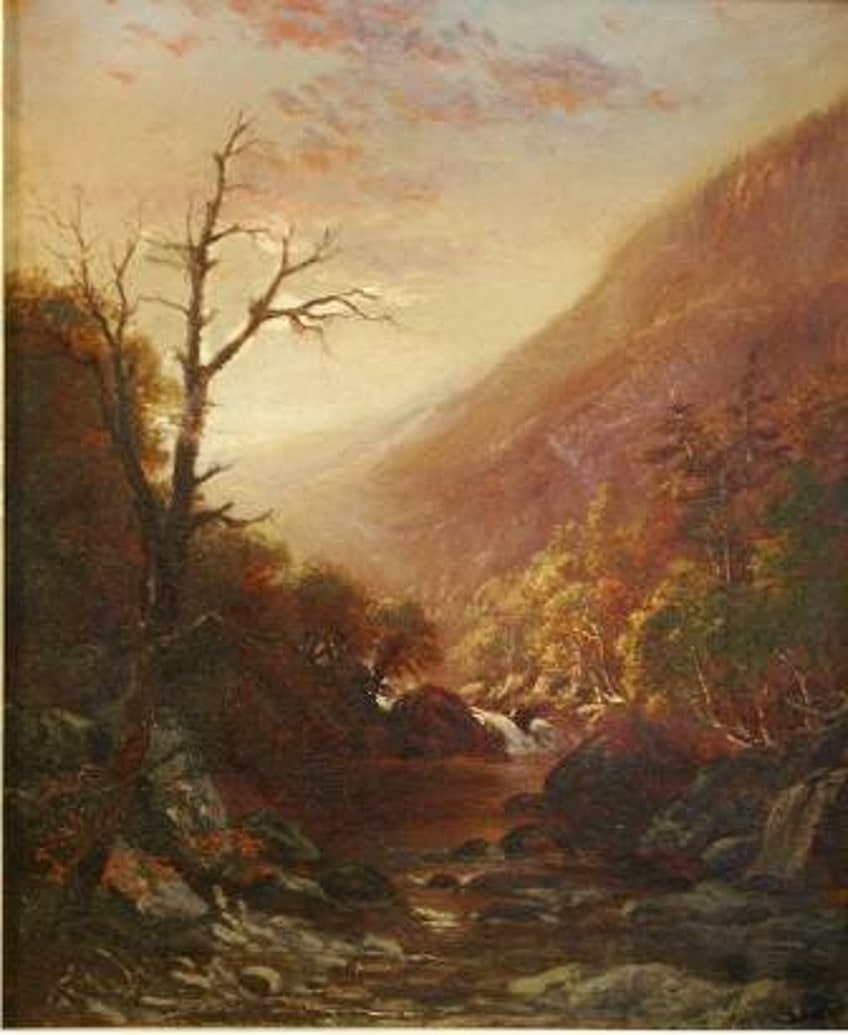
Her work was exhibited at the National Academy of Design, the Pennsylvania Academy of the Fine Arts, and the Brooklyn Art Association, to name a few. During her time women did not have the same opportunities to have their works exhibited, which led to a number of her works going unnoticed until art historians revisited the contributions of women artists from the Hudson River School.
The title of an amateur artist was equally accessible to women and men, however any title indicating that of a professional artist was generally reserved for men and far less available for women.
Making note of incredible artists such as Barstow, we should be careful not to take the records of her work for granted. The lack of information accessible regarding women artists will have us believe that Barstow was the exception, rather than simply recognizing that her work was exceptional, much like the work of her female contemporaries. Especially those, who because of their gender were faced with many barriers that suppressed their accomplishments from getting the due they deserved.
These famous Romanticism paintings that we selected for our list are truly magnificent examples of the imaginative and spirited artworks that artists contributed to the movement. Their influence holds to this day, as they shaped movements that followed and generations of artists that succeeded them. If you are curious to learn more about art history, browse through our website, where you are sure to find more articles to pique your interest!
Read also our romanticism paintings web story.
Frequently Asked Questions
What Is Romanticism?
The Romanticism movement dominated Europe in the late 18th century. It was an artistic, intellectual, and literary movement cultivated as a reaction to the Classicism and Neoclassicism movements that preceded it. A distinct break from the trends of intellectual thought, industrialization, rationalization, and glorification of science. The Romanticism movement was emotionally charged and sought to entertain the imagination, we see that in the fantastical and inspired paintings that emerged from this period.
What Are the Characteristics of Romanticism Art?
Romanticism indulged the artist’s emotions and imagination, allowing these feelings and ideas to permeate the viewer. Romantic-era paintings highlighted the individual, the personal, the subjective, the imaginative, the emotional, the transcendental, the visionary, and the sublime.
How Is Romanticism Shown in Art?
In Romanticism portraits and Romanticism art pieces, artists portrayed scenes of love, beauty, suspense, horror, anger, and adoration that were aimed to provide an escape from reality. Romantic-era paintings paid homage to the power of nature, honoring its unpredictability and beauty. Nature’s potential for disaster was prominently shown in art, along with the portrayal of commanding, poignant feelings that induced empathy. Romantics glorified emotion and intuition over logic and intellect. Romanticism art was attuned to beautiful scenes of nature or the sublime, incorporating the way humans feel in nature. Danger and beauty defined nature’s sublime aesthetic. Romanticism portraits and Romanticism art pieces exhibited bright colors and energetic brushstrokes. Famous Romantic art favored dynamic compositions over static ones. Romantic-era paintings were used to express individuality and instinct instead of depicting idealized representations of the Classical past.

Emma completed her Bachelor’s Degree in International Studies at the University of Stellenbosch. She majored in French, Political Science, and History. She graduated cum laude with a Postgraduate Diploma in Intercultural Communication. However, with all of these diverse interests, she became confused about what occupation to pursue. While exploring career options Emma interned at a nonprofit organization as a social media manager and content creator. This confirmed what she had always known deep down, that writing was her true passion.
Growing up, Emma was exposed to the world of art at an early age thanks to her artist father. As she grew older her interests in art and history collided and she spent hours pouring over artists’ biographies and books about art movements. Primitivism, Art Nouveau, and Surrealism are some of her favorite art movements. By joining the Art in Context team, she has set foot on a career path that has allowed her to explore all of her interests in a creative and dynamic way.
Learn more about the Art in Context Team.
Cite this Article
Emma, Littleton, “Famous Romanticism Paintings – The Best Examples of Romantic-Era Art.” Art in Context. February 9, 2022. URL: https://artincontext.org/famous-romanticism-paintings/
Littleton, E. (2022, 9 February). Famous Romanticism Paintings – The Best Examples of Romantic-Era Art. Art in Context. https://artincontext.org/famous-romanticism-paintings/
Littleton, Emma. “Famous Romanticism Paintings – The Best Examples of Romantic-Era Art.” Art in Context, February 9, 2022. https://artincontext.org/famous-romanticism-paintings/.


